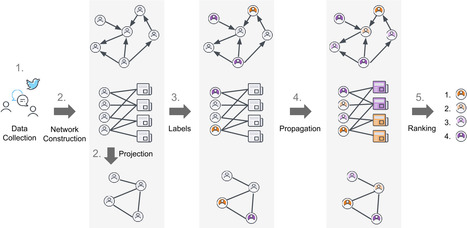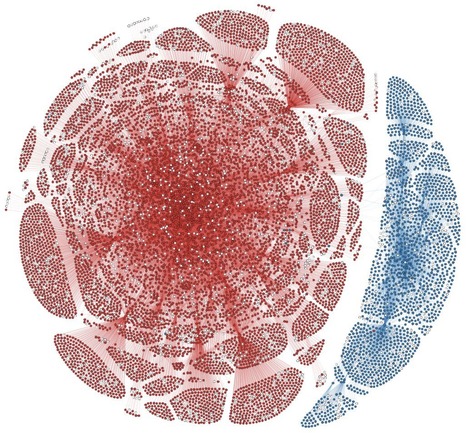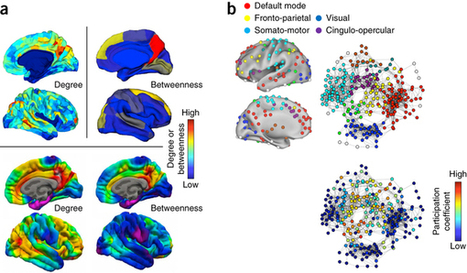 Your new post is loading...
 Your new post is loading...

|
Suggested by
Fil Menczer
|
Bao Tran Truong, Oliver Melbourne Allen & Filippo Menczer
EPJ Data Science volume 13, Article number: 10 (2024) The spread of misinformation poses a threat to the social media ecosystem. Effective countermeasures to mitigate this threat require that social media platforms be able to accurately detect low-credibility accounts even before the content they share can be classified as misinformation. Here we present methods to infer account credibility from information diffusion patterns, in particular leveraging two networks: the reshare network, capturing an account’s trust in other accounts, and the bipartite account-source network, capturing an account’s trust in media sources. We extend network centrality measures and graph embedding techniques, systematically comparing these algorithms on data from diverse contexts and social media platforms. We demonstrate that both kinds of trust networks provide useful signals for estimating account credibility. Some of the proposed methods yield high accuracy, providing promising solutions to promote the dissemination of reliable information in online communities. Two kinds of homophily emerge from our results: accounts tend to have similar credibility if they reshare each other’s content or share content from similar sources. Our methodology invites further investigation into the relationship between accounts and news sources to better characterize misinformation spreaders. Read the full article at: epjdatascience.springeropen.com

|
Suggested by
Fil Menczer
|
Christopher Torres-Lugo, Kai-Cheng Yang, Filippo Menczer A growing body of evidence points to critical vulnerabilities of social media, such as the emergence of partisan echo chambers and the viral spread of misinformation. We show that these vulnerabilities are amplified by abusive behaviors associated with so-called ''follow trains'' on Twitter, in which long lists of like-minded accounts are mentioned for others to follow. This leads to the formation of highly dense and hierarchical echo chambers. We present the first systematic analysis of U.S. political train networks, which involve many thousands of hyper-partisan accounts. These accounts engage in various suspicious behaviors, including some that violate platform policies: we find evidence of inauthentic automated accounts, artificial inflation of friends and followers, and abnormal content deletion. The networks are also responsible for amplifying toxic content from low-credibility and conspiratorial sources. Platforms may be reluctant to curb this kind of abuse for fear of being accused of political bias. As a result, the political echo chambers manufactured by follow trains grow denser and train accounts accumulate influence; even political leaders occasionally engage with them.
Within an ecosystem, species interact with each other in many different ways, including predation, competition, and facilitation, and this can be modelled as a network of multiple interaction types. The variety of interaction types that link species to each other has long been recognized but has rarely been synthesized for entire multi-species ecosystems. Here, we leverage a unique marine ecological network that integrates thousands of trophic and non-trophic interactions. We show that, despite its multidimensional complexity, this ecological network collapses into a small set of “functional groups,” i.e., groups of species that resemble each other in the way they interact with others in their combined trophic and non-trophic interactions. These groups are taxonomically coherent and predictable by species attributes. Moreover, dynamic simulations suggest that the way the different interaction types relate to each other allows for higher species persistence and higher total biomass than is expected by chance alone, and that this tends to promote a higher robustness to extinctions. Our results will help to guide future empirical studies and to develop a more general theory of the dynamics of complex ecological systems. Kéfi S, Miele V, Wieters EA, Navarrete SA, Berlow EL (2016) How Structured Is the Entangled Bank? The Surprisingly Simple Organization of Multiplex Ecological Networks Leads to Increased Persistence and Resilience. PLoS Biol 14(8): e1002527. http://dx.doi.org/10.1371/journal.pbio.1002527
Via Eric L Berlow

|
Suggested by
Segismundo
|
Here we develop an approach and propose a quantity (measure) which is simple enough to be widely applicable, reveals a number of universal features of the organization of real-world networks and, as we demonstrate, is capable of capturing the essential features of the structure and the degree of hierarchy in a complex network.
Studies of ecological networks (the web of interactions between species in a community) demonstrate an intricate link between a community’s structure and its long-term viability. It remains unclear, however, how much a community’s persistence depends on the identities of the species present, or how much the role played by each species varies as a function of the community in which it is found. We measured species’ roles by studying how species are embedded within the overall network and the subsequent dynamic implications. Using data from 32 empirical food webs, we find that species’ roles and dynamic importance are inherent species attributes and can be extrapolated across communities on the basis of taxonomic classification alone. Our results illustrate the variability of roles across species and communities and the relative importance of distinct species groups when attempting to conserve ecological communities.
We introduce a new method to efficiently approximate the number of infections resulting from a given initially-infected node in a network of susceptible individuals, based on counting the number of possible infection paths of various lengths to each other node in the network. We analytically study the properties of our method systematically, in particular demonstrating different forms for SIS and SIR disease spreading (e.g. under the SIR model our method counts self-avoiding walks). In comparison to existing methods to infer the spreading efficiency of different nodes in the network (based on degree, k-shell decomposition analysis and different centrality measures), our method directly considers the spreading process, and as such is unique in providing estimation of actual numbers of infections. Crucially, in simulating infections on various real-world networks with the SIR model, we show that our walks-based method improves the inference of effectiveness of nodes over a wide range of infection rates compared to existing methods. We also analyse the trade-off between estimate accuracy and computational cost of our method, showing that the better accuracy here can still be obtained at a comparable computational cost to other methods.
|
MICHAŁ B. PARADOWSKI, AGNIESZKA CIERPICH–KOZIEŁ, CHIH–CHUN CHEN, JEREMI K. OCHAB MLJ Volume106, Issue4 Winter 2022 Pages 694-725 This data-driven study framed in the interactionist approach investigates the influence of social graph topology and peer interaction dynamics among foreign exchange students enrolled in an intensive German language course on second language acquisition (SLA) outcomes. Applying the algorithms and metrics of computational social network analysis (SNA), we find that (a) the best predictor of target language (TL) performance is reciprocal interactions in the language being acquired, (b) the proportion of output in the TL is a stronger predictor than input (Principle of Proportional Output), (c) there is a negative relationship between performance and interactions with same-first-language speakers, (d) a significantly underperforming English native-speaker dominated cluster is present, and (e) there are more intense interactions taking place between students of different proficiency levels. Unlike previous study abroad social network research concentrating on the microlevel of individual learners’ egocentric networks and presenting an emic view only, this study constitutes the first application of computational SNA to a complete learner network (sociogram). It provides new insights into the link between social relations and SLA with an etic perspective, showing how social network configuration and peer learner interaction are stronger predictors of TL performance than individual factors such as attitude or motivation, and offering a rigorous methodology for investigating the phenomenon. Read the full article at: onlinelibrary.wiley.com

|
Suggested by
mohsen mosleh
|
Mohsen Mosleh, Gordon Pennycook, Antonio Arechar, David Rand Social media is playing an increasingly large role in everyday life. Thus, it is of both scientific and practical interest to understand behavior on social media platforms. Furthermore, social media provides a unique window for social scientists to deepen our understanding of the human mind. Here we investigate the relationship between individual differences in cognitive reflection and behavior on Twitter in a sample of large N = 1,953 users recruited via Prolific Academic. In doing so, we differentiate between two competing accounts of human information processing: an “intuitionist” account whereby reflection plays little role in daily life, and a “reflectionist” account whereby reflection (and, in particular, overriding intuitive responses) does play an important role. We found that people who score higher on the Cognitive Reflection Test (CRT) – a widely used measure of reflective thinking – were more discerning in their social media use: They followed more selectively, shared news content from more reliable sources, and tweeted about weightier subjects. Furthermore, a network analysis indicated that the phenomenon of echo chambers, in which discourse is more likely with like-minded others, is not limited to politics: we observe “cognitive echo chambers” in which people low on cognitive reflection tend to follow the same set of accounts. Our results help to illuminate the drivers of behavior on social media platforms, and challenge intuitionist notions that reflective thinking is unimportant for everyday judgment and decision-making.
The confluence of new approaches in recording patterns of brain connectivity and quantitative analytic tools from network science has opened new avenues toward understanding the organization and function of brain networks. Descriptive network models of brain structural and functional connectivity have made several important contributions; for example, in the mapping of putative network hubs and network communities. Building on the importance of anatomical and functional interactions, network models have provided insight into the basic structures and mechanisms that enable integrative neural processes. Network models have also been instrumental in understanding the role of structural brain networks in generating spatially and temporally organized brain activity. Despite these contributions, network models are subject to limitations in methodology and interpretation, and they face many challenges as brain connectivity data sets continue to increase in detail and complexity.
Contributions and challenges for network models in cognitive neuroscience
• Olaf Sporns
Nature Neuroscience (2014) http://dx.doi.org/10.1038/nn.3690
In the past decade, ecologists have increasingly applied complex network theory (1, 2) to ecological interactions, both in entire food webs (3) and in networks representing ecological interactions, especially those between plants and their animal pollinators or seed dispersers (4). How important are individual species to the maintenance of such ecological networks? On page 1489 of this issue, Stouffer et al. (5) analyze terrestrial, freshwater, and marine food webs to infer the contributions of individual species to network stability. In a related field study on page 1486 of this issue, Aizen et al. (6) explore plant and pollinator webs on a landscape scale. Using a different field study design, Pocock et al. (7) recently focused on a local community in which several webs of different kinds of interactions and organisms form a composite network.
Identifying and removing spurious links in complex networks is meaningful for many real applications and is crucial for improving the reliability of network data, which, in turn, can lead to a better understanding of the highly interconnected nature of various social, biological, and communication systems. In this paper, we study the features of different simple spurious link elimination methods, revealing that they may lead to the distortion of networks’ structural and dynamical properties. Accordingly, we propose a hybrid method that combines similarity-based index and edge-betweenness centrality. We show that our method can effectively eliminate the spurious interactions while leaving the network connected and preserving the network's functionalities.
|



 Your new post is loading...
Your new post is loading...
















